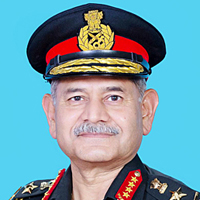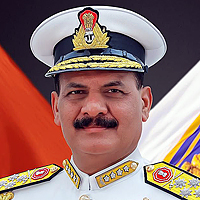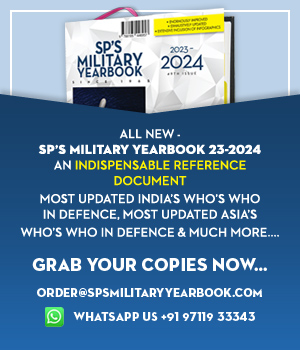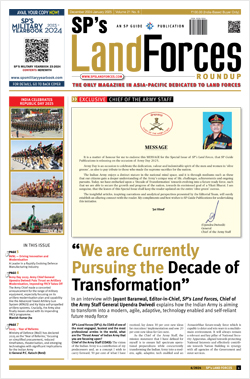INDIAN ARMED FORCES CHIEFS ON OUR RELENTLESS AND FOCUSED PUBLISHING EFFORTS

The insightful articles, inspiring narrations and analytical perspectives presented by the Editorial Team, establish an alluring connect with the reader. My compliments and best wishes to SP Guide Publications.

"Over the past 60 years, the growth of SP Guide Publications has mirrored the rising stature of Indian Navy. Its well-researched and informative magazines on Defence and Aerospace sector have served to shape an educated opinion of our military personnel, policy makers and the public alike. I wish SP's Publication team continued success, fair winds and following seas in all future endeavour!"

Since, its inception in 1964, SP Guide Publications has consistently demonstrated commitment to high-quality journalism in the aerospace and defence sectors, earning a well-deserved reputation as Asia's largest media house in this domain. I wish SP Guide Publications continued success in its pursuit of excellence.
- The layered Air Defence systems that worked superbly, the key element of Operation Sindoor
- Operation Sindoor | Day 2 DGMOs Briefing
- Operation Sindoor: Resolute yet Restrained
- India's Operation Sindoor Sends a Clear Message to Terror and the World – ‘ZERO TOLERANCE’
- Japan and India set forth a defence cooperation consultancy framework, talks on tank and jet engines
- Lt General Pratik Sharma takes over Command of Indian Army's Northern Command
- Major General Lisamma P.V. assumes the appointment of ADG, MNS
- Uzbekistan's progressive transformation is a bright spot in Central Asia; boosts cultural ties with India
- Terrorist Attack in Pahalgam in Kashmir: Unfolding a long surgical war against PAK
SIPRI publishes global arms transfer data from 2013 to 2017
The Stockholm International Peace Research Institute (SIPRI) has revealed new data on arms transfers showing a 10 per cent increase in the volume of international major weapons transfers in 2013-17 from 2008-12. Between the 2008-12 and 2013-17 periods, the flow of arms increased to Asia and Oceania and to the Middle East, while Africa, the Americas, and Europe reported a fall in the supply of arms during the time.
In 2013-17, the five biggest arms exporters, the US, Russia, France, Germany, and China accounted for 74 per cent of all weapons exports. During the period, the US accounted for 34 per cent of total arms exports, which increased by 25 per cent from 2008-12. According to SIPRI, the country exported major arms to 98 states in 2013-17, with exports to states in the Middle East accounting for 49 per cent of the total US arms exports in that period. China is reported to be the fifth largest arms supplier, with exports registered to have significantly increased by 38 per cent from 2008-12 to 2013-17.
Israel, South Korea, and Turkey have reportedly enhanced their arms supply by 55 per cent, 65 per cent, and 145 per cent respectively. In terms of arms imports, Middle East states registered a significant rise of 103 per cent from 2008-12 to 2013-17 and accounted for 32 per cent of global arms imports in 2013-17. In 2013-17, Saudi Arabia was reported to be the world’s second-largest arms importer, while Egypt was the third largest and the United Arab Emirates (UAE) was the fourth largest.
During the period, India became the largest importer of major arms in the world and accounted for 12 per cent of the global arms import. The country reported an increase of 24 per cent in 2013-17.
The SIPRI Arms Transfers Database provides data on all international transfers of major weapons, including sales, gifts, and production licences, between states, international organisations, and armed nonstate groups.





